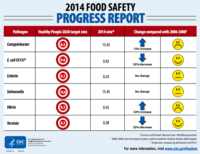New findings about foodborne illness risk factors in fast food and full-service restaurants have been released by the U.S. Food and Drug Administration (FDA). The report is entitled “Report on the Occurrence of Foodborne Illness Risk Factors in Fast Food and Full Service Restaurants, 2013-2014 ”. The current study serves as a follow up of sorts to a previous 10-year study conducted between 1998 and 2008.
Study Focus
FDA has evaluated trends in food preparation practices and employee behaviors that contribute to foodborne illness outbreaks in the retail setting. Conducted as a national observational study, the study delves into the relationship between food safety management systems, certified food protection managers, and the occurrence of risk factors and food safety behaviors/practices commonly associated with foodborne illness in restaurants.
Restaurant Categories
For the purposes of this study, FDA defined a “full-service” restaurant as “a restaurant where customers place their order at their table, are served their meal at their table, receive the service of the wait staff, and pay at the end of the meal.”
A “fast food” restaurant was defined as “a restaurant that is not a full-service restaurant. This includes restaurants commonly referred to as quick-service restaurants and fast-casual restaurants.”
Data Time Period
The data released today is just the first phase of what is planned to be a 10-year study. It covers data collected between Nov. 15, 2013 to Sept. 30, 2014. The second data collection took place from Oct. 1, 2017 to Sept. 30, 2018, but that is not the data that has been released today. The third data collection will take place from Oct. 1, 2021 to Sept. 30, 2022.
Findings from the 2013-2014 Data Set
Of the food safety behaviors/practices investigated in this study, restaurants had the best control over ensuring no bare hand contact with ready-to-eat foods and cooking raw animal foods to their required temperatures.
The study also showed there remains a need to gain better control over employee handwashing and proper temperature control of foods that require refrigeration (cold holding of foods).
Data Usage
With this data, FDA believes that restaurant management can better address and reduce common unsafe behaviors/practices within fast food and full-service restaurants. FDA and restaurant operators can use the data to develop new food safety initiatives, identify priorities, help to determine the allocation of resources, and more. FDA’s National Retail Food Team will continue to work with stakeholders, such as the National Restaurant Association, National Council of Chain Restaurants, restaurant chain companies and state restaurant associations in addressing food safety behaviors/practices in need of attention.
See the 84-page report in its entirety at FDA.gov.
Sign up for Food Safety Magazine’s bi-weekly emails!
Subscribe to our podcast: Food Safety Matters!




